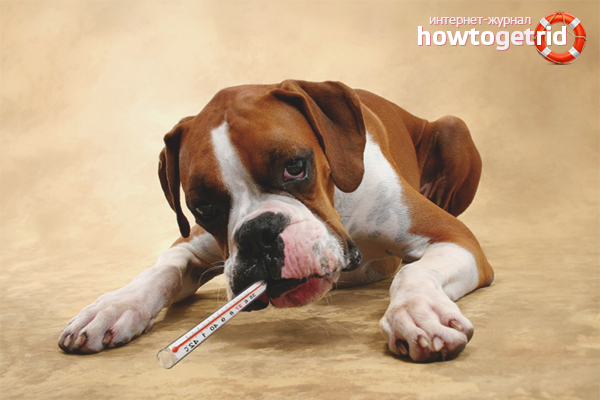The content of the article
Every caring owner wants his ward to be always cheerful and cheerful. There are cases when the temperature rises in dogs, and there is no rectal thermometer at hand. In time indicated illness will save the pet from the deterioration of the body. Experienced veterinarians and dog experts have developed a specific scheme that allows in a short time to identify fever and malaise. Consider the important aspects in order.
Causes of increased temperature in dogs
- accumulation of toxins and poisons in the body;
- bacterial infection;
- lack of vitamins and minerals;
- malignant tumors on the internal organs;
- brain damage;
- high physical activity;
- dehydration.
Important!
Pay attention to the listed symptoms. If the fever lasts longer than a day, immediately contact your veterinarian.It is important to eliminate the cause in time with the help of antipyretic drugs.
How to measure the temperature of the dog
Method number 1. Touch the pet's nose
The humidity of the nose and the body temperature of the dog varies within acceptable limits. Pet's nose becomes dry immediately after waking up from sleep, with prolonged exposure to the sun and excessive physical activity, when the body is dehydrated. Pay attention to these factors, if they are absent - the pet is sick. In all other cases, eliminate the cause of dry nose.
Method number 2.Pay attention to the gums of the animal
A feature of increasing the temperature in dogs is a change in the gums. If they are dry and warm, the pet is most likely picked up by the virus. In a healthy dog, the oral cavity is the same shade without any foreign inclusions. The normal color of the gums is pale pink, like in humans. Regarding the structure, they should be shiny and wet. To correctly determine the condition of the dog at the moment, raise the animal's upper lip, stick your finger under it, then feel the area in the canine zone.
If the humidity and temperature are similar to human, the pet is healthy. In all other cases, it is recommended to take measures that will help bring down the temperature. Without fail, after feeling in this area, pay attention to its color. Brown maroon gums are a consequence of high temperature, in particular, sepsis.
Method number 3. Watch your pet's behavior
In addition to the above measures, it is necessary to monitor the general condition of the pet. In case of too high temperature, touch the dog's body, the heat spreads to all zones.You will fully feel the heat, if you put a pet next to you (without touching it at all). In such a situation, contact your doctor immediately.
Pay attention to other important aspects. If the dog suffers from shortness of breath, substitute the cheek to its mouth in order to feel hot breath. If the pet family has a high temperature, it will drink 2-2.5 times more, because the body will need water. As in humans, a dog in a feverish state experiences physical activity difficulties. This is because the animal has sore joints.
Method number 4. Touch the paws and ears of your pet.
An important criterion of the disease in dogs is considered to be an increase in the optimal temperature index in the area of the ears and paws. Touch these parts with your cheek, the back of your hand, or the wrist area (any sensitive area that allows you to identify the ailment). If the temperature of the pet's skin is significantly different from yours, the animal does not feel well.
This move allows you to quickly find out the state of health of the animal for the reason that in these areas there are a large number of blood vessels.When an infection occurs, the virus also enters this area, so the immune system begins to fight. From here there is an accelerated blood circulation and, as a result, enhanced heat generation.
It is important to understand that the temperature on both ears is measured in this way. When the skin on one of them is different from the other, it rather means that the pet has inflammation of the ear canal, rather than a rise in body temperature.
Method number 5. Estimate the temperature of the underarms and groin
The main function of the lymph nodes is to clean the blood of bacteria, remove the virus from the body and prevent its further spread. With all this, after removing the infection, the lymph nodes are filled with new immune cells,body restructuring begins. They become inflamed, the temperature in this area rises as a result of the fight against viruses.
A pet with a high temperature behaves sluggishly, may limp or move awkwardly. Often in dogs in a similar state, irritability, vomiting, and increased wool content are observed. Try all methods, then take the appropriate measures.
Video: how to measure the temperature of the animal











To send